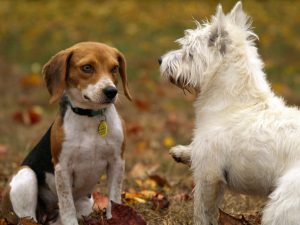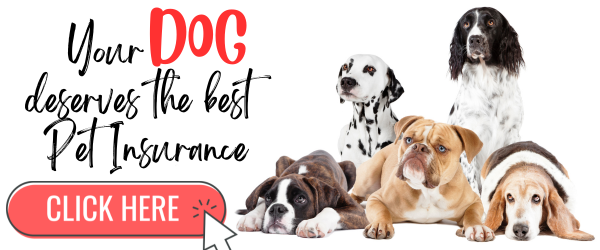Having socialization is essential for raising a puppy into a well-rounded adult. Without it, the normal everyday life can be very confusing and overwhelming for our dogs. Unfortunately, most people have a misconception of what socialization actually entails. We can sometimes do more harm than good when socializing our puppies, so what is the right way to go about it? Let’s talk about how we can prevent mistakes that could potentially set us back.
Getting a puppy used to socialization was traditionally done by taking them out on a leash, introducing them to new people and other dogs, and exposing them to different sights, smells, and places. Assuming everything went off without a hitch, your canine companion would then be accustomed to their surroundings. However, there were some drawbacks.
A disadvantage, no matter the outcome of the situation, is that a dog may become overly excited when it spots someone or another dog. Issues with pulling can arise, such as when dogs run up to people who don’t like them, aren’t interested in being bothered, or are scared of an overly-excited canine. Additionally, if a dog rushes to greet another that is not very socialized or one that isn’t playful and instead tends to be more serious this could result in a fight.
Getting a puppy and having it socialize by getting used to people, places and things in the environment is a modern and beneficial way of looking at it. This should be done so that all these elements are seen as just background noise. We should be the focus of our dogs, rather than strangers and their pets. We should provide them guidance, leadership, and direction instead of relying on people to give them rewards without any strings attached or hoping for a potential play session with other canines that could end poorly.
In order for our social interactions to be enjoyable, we must have a handle on the situation and demonstrate to our puppy that we are in charge of its life and schedule. To start, we’ll use a leash and a crate. We also need to show the pup that we’re the source of fun and attention, not others or other dogs. We do this by rewarding them during mark training with treats and attention. We can teach a puppy by simply marking desired behaviors without giving commands, then rewarding them with a treat. To do this, we use either a clicker or say “Yes” and give the puppy the treat afterwards.
Gaining engagement is the primary objective of this period; you desire your canine to watch you for instructions. This is the foundation of all training. In order for your dog to listen to you, it needs to be focused on you; not sniffing the ground, observing squirrels, or looking at other people. To ensure that your puppy is paying close attention, it should disregard all other distractions.
When rewarding the puppy, use treats of high value. Don’t settle for dry dog biscuits; instead opt for cooked meat, small pieces of string cheese, and top-quality soft treats. Each time the puppy looks our way, we can mark and reward them. The pup is taught to focus on ourselves and observe us. Furthermore, this is done in advance of feeding times to ensure they’re eager for the meal. To the puppy, we become their superstar with a delicious meal that comes precisely when they’re hungry!

Begin practicing in areas with minimal disruption and progress from there. Your house, yard, etc. are optimal spots to start. After your pup becomes more involved during training, gradually increase distractions. We suggest you avoid dog parks, and rather find a quieter area such as a corner in the park, an empty basketball court, or an unoccupied soccer field – these are all ideal places to practice with less distraction. Your pup’s attentiveness can be tested with more stimulating environments, so maintain a lively atmosphere to prevent your dog from being easily distracted by its surroundings.
People will be the main issue when you are attempting to socialize your puppy; as you can imagine, people will likely disregard what you tell them if they want to pet or interact with your puppy. Do not be hesitant to ask someone to give you and your puppy space; you should prioritize the progress of your pup over someone who can’t obey simple orders in regards to him/her.
To handle people and situations that make your pup uneasy, the best thing to do is to re-engage them and give treats or play training games in order to help them relax. The environment can be a source of fear, but with this process, it is possible to make these intimidating elements into something akin to white noise in the background; something not noteworthy enough for attention.
The best idea is to steer clear of the problem in the first place. Your pup doesn’t need canine companions; they have you. Dogs don’t require play dates for gaining social skills as young kids do. If your dog chooses to ignore other dogs its entire life, there won’t be any issues at all. If you must have canines as companions, then adult dogs that are indifferent and ignore them are the best to socialize with. It is not advisable to let them mingle with other puppies since they’ll likely want to play together. It’s not wise to introduce your dogs to unfamiliar canines, as most people don’t understand dog body language, and one attack is all it takes for your pup to become aggressive toward other dogs for the rest of its life.
We discussed earlier how the key to successful socialization is providing positive experiences and having control. Your pup, as well as grown dogs, look to you for safety–especially when it comes to strange dogs that are not on leashes. Under no circumstances should your dog decide, on its own, when to fight preemptively in order to protect itself from potential danger. If you cannot handle it yourself, they will have no choice but to resort to violence in order to defend themselves. It’s up to you to safeguard your pup; carry a walking stick or pepper spray and interpose yourself between them and the other dog. If that doesn’t work, take whatever action is necessary so that your puppy knows it’s safe with you and won’t have to bite out of self-defense.
 wagwagtail "only love can make your dog wag her tail"
wagwagtail "only love can make your dog wag her tail"
